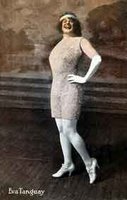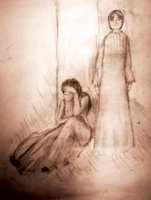
BURTIS OPERA HOUSEFINEST HOTEL IN THE WEST DURING CIVIL WAR DAYS WAS THE BURTIS HOUSE AT FIFTH AND IOWA STREETSOpened December 25, 1867. The Burtis Opera House is a fine structure with a seating capacity of 1600.Sopranos...Symphony...Salty....Burtis had it all Truly, Davenport was built on the arts. Before there were paved streets and running water to homes in the city, there were opera houses with 40 foot domed ceilings where Chicago operatic troupes traveled on horseback to perform. The most famous of these was the Burtis Opera House.
Burtis Opera House5th and Iowa Streets
Burtis House 1867 starred greats such as
Lillian Russel, Edwin Booth, Sara Bernhardt, Maurice Barrymore, Otis Skinner, Madame Modjeska, Della Fox
Destroyed in a fire April 26, 1921 it was restored to only about 1/3 it's original structure.
February 8, 1907Southeastern Iowa lumbermen met in Davenport and attended Eva Tanguay performance at Burtis Opera House.Eva Tanguay (born August 1, 1879 in Marbleton, Québec, Canada died January 11, 1947 in Hollywood, California, United States) was a singer and entertainer known as "the girl who made vaudeville famous."Eva TanguayEva Tanguay's family moved from Quebec's Eastern Townships to the United States when she was a child where she developed an interest in the performing arts, making her first appearance on stage at the age of eight. With her parents assistance, she pursued a show business career, working her way through a variety of amateur contests that eventually landed her a spot with a comedy troupe before making her vaudeville debut in New York city in 1904.Although she possessed only an average voice, the enthusiasm with which the robust Eva Tanguay performed her raunchy songs soon made her an audience favorite. She went on to have one of the most long-lasting vaudeville careers and eventually commanded one of the highest salaries of any performer of the day. After seeing her perform, English poet and sexual revolutionary Aleister Crowley called Tanguay America's equivalent to Europe's music hall greats, Marie Lloyd of England and Yvette Guilbert of France.Eva Tanguay is remembered for brassy self-confident songs that symbolized the emancipated woman such as "Its All Been Done Before But Not the Way I Do It." In showbiz circles, she was nicknamed the "I Don’t Care Girl," after her most famous song, "I Don’t Care What Happens to Me."Tanguay sang on a few gramophone records for Nordskog Records. In addition to her singing career, she also starred in two film comedies that, despite the limitations of silent film, used the screen to capture her lusty stage vitality to its fullest. The first, titled Energetic Eva was made in 1916 and the following year she starred opposite Tom Moore in The Wild Girl.Eva Tanguay retired from show business in the 1930s and died in 1947 in Hollywood where she was interred in the Hollywood Forever Cemetery.In 1953 Mitzi Gaynor portrayed Eva Tanguay in a fictionalized version of her life in the Hollywood motion picture, The I Don't Care Girl.January 9, 1907
Florizel Reuter and Arthur Newstead gave concert at Burtis opera house.Musical Prodigies: Florizel von Reuter (1890-1985) ViolinistAlthough he was an American boy, he primarily performed as a prodigy in Europe. Florizel was born Florizel Reuter on January 21, 1890 in Davenport, Iowa. His father was a musician and minor composer named Jacob Reuter. His first professional concert was in La Chaux-de-Fonds in Switzerland in about 1900.Arthur Newstead PianistArthur Newstead was born in London August 4, 1881 and studied piano at the Royal Academy of Music under Oscar Beringer and later with Harold Bauer. Months after his graduation from the Royal Academy, his distinction, earned from many masterful concert performances, promoted him to Professor of that institution at the young age of 21 years. After two years, Newstead was forced to resign his position due to numerous public engagements following his tremendous success at an orchestral concert in which he played three concertos by Beethoven, Liszt, and Saint Saëns. Arthur Newstead died in his home in New York City on April 1, 1952.
In 1856, the German Strasser Union Marching Band of Davenport was formed. When the Tri City Symphony Orchestra was founded in 1916, it was the twelfth in the nation but having drawn two-thirds of it's membership from the Strasser Marching Band, it is debated by many as the oldest music organization in the country to have formed a symphonic orchestra.The first concert took place on May 29, 1916, at the Burtis Opera House, Davenport, under the baton of Ludwig Becker, a German-born concert violinist. If the arithmetic doesn't add up, that's because they decided that concert would be the first and last of the 1915-16 season.1877
There was a small audience for the Emma Abbott concert in the Burtis Opera House, Davenport, last night. Whenever Davenport theaters have a crowd, Rock Island and Moline people must provide it, and the people of those cities heard her in Moline the night before.Emma Abbott (December 9, 1850 – January 5, 1891), American opera singer, was born in Chicago, Illinois and studied in Milan and Paris. She had a fine soprano voice, and appeared first in opera in London under Colonel Mapleson's direction at Covent Garden, also singing at important concerts. She organized an opera company known by her name, and toured extensively in the United States, where she enjoyed considerable reputation. In 1873 she married E. J. Wethereil. She died at Salt Lake City.


